The 7 Best US Airlines for In-Flight Wi-Fi in 2018
Mar 14, 2018 | Share
Industry Exclusive/Entertainment, Internet Speed Guides
Whether it’s for business or simply because of a debatably unhealthy obsession, many of us struggle going more than a few minutes without internet access. This can be particularly troublesome when traveling. To make sure we stay as connected as possible, we need to know which airlines do the most to keep us online while in the air.
Through painstaking research and expert data analysis, our team at HighSpeedInternet.com is proud to bring you our exclusive rankings of the in-flight Wi-Fi offerings of domestic airlines. Learn more about our methodology for these rankings below.
Top Domestic Airline Wi-Fi Services Overall
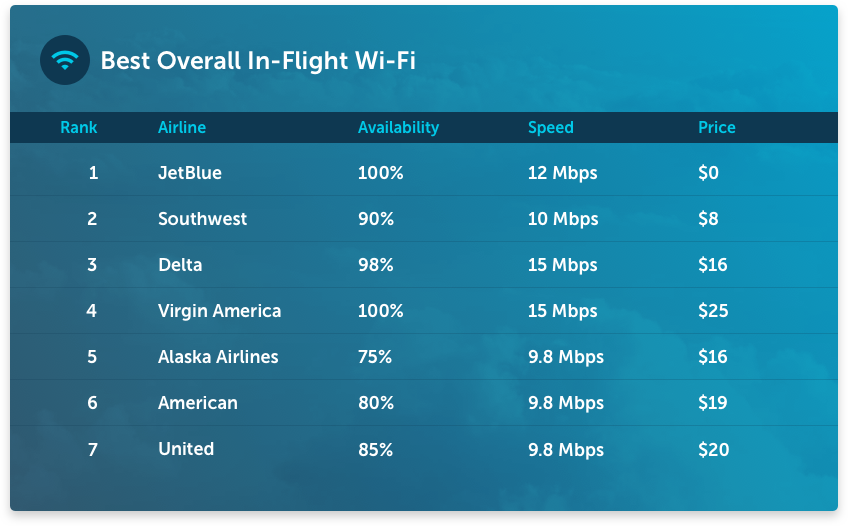
What is ASM?
The industry standard for measuring the total service capacity of an airline is Available Seat Miles (ASM). To calculate an airline’s ASM, multiply the total number of seats in its fleet of planes by the total number of miles the airline flies in a year. Our availability statistic is the percentage of an airline’s ASM on which it offers Wi-Fi.
JetBlue offers the best overall in-flight Wi-Fi for personal travel.
The biggest reason JetBlue tops our rankings is because not only is it widely available, it comes at no extra cost. JetBlue is the only airline in America that offers free in-flight Wi-Fi.
Along with being the most affordable, JetBlue’s in-flight Wi-Fi was among the fastest (tied with Delta and Virgin America at 15 Mbps) in our original iteration of this data. However, while updating this piece, we found JetBlue is now advertising speeds of just 12 Mbps. It’s a small decrease, but we were curious about why it happened. Digging a little deeper, we found that it may stem from JetBlue’s Internet Service Provider, ViaSat.
ViaSat launched a new satellite in June 2017. Positioning the satellite took a few months, and then the satellite entered an interim phase where the company began testing its functionality. During this phase, ViaSat has been conservative with the speeds it promises, but we expect speeds to pick up soon, as ViaSat continues to dial in its new satellite. This may be a possible explanation for JetBlue’s recent drop in speed, although it’s still unclear whether this directly relates to ViaSat’s in-flight Wi-Fi services or not.
Southwest grabbed the second spot with a great balance of affordability and availability. It offers in-flight Wi-Fi on 90% of its ASM and charges just $8 per day.
Virgin America and Jet Blue are the only airlines in America offering in-flight Wi-Fi on 100% of their ASM.
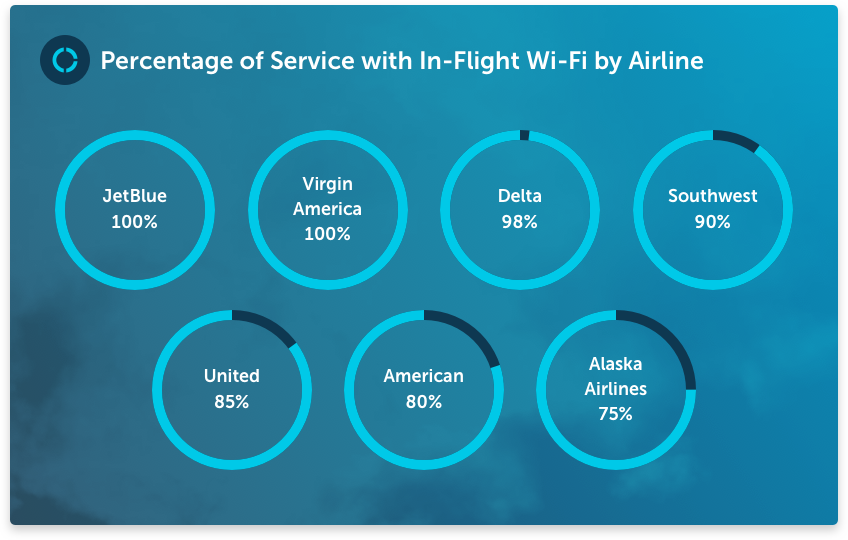
JetBlue and Virgin America lead the pack, offering in-flight Wi-Fi on 100% of their ASM. The downside for Virgin America is that its in-flight Wi-Fi is the most expensive—it costs up to $25 per day.
Delta was a close second in availability, offering in-flight Wi-Fi on 98% of its ASM.
Delta and Virgin America tied for the fastest in-flight Wi-Fi at speeds up to 15 Mbps.
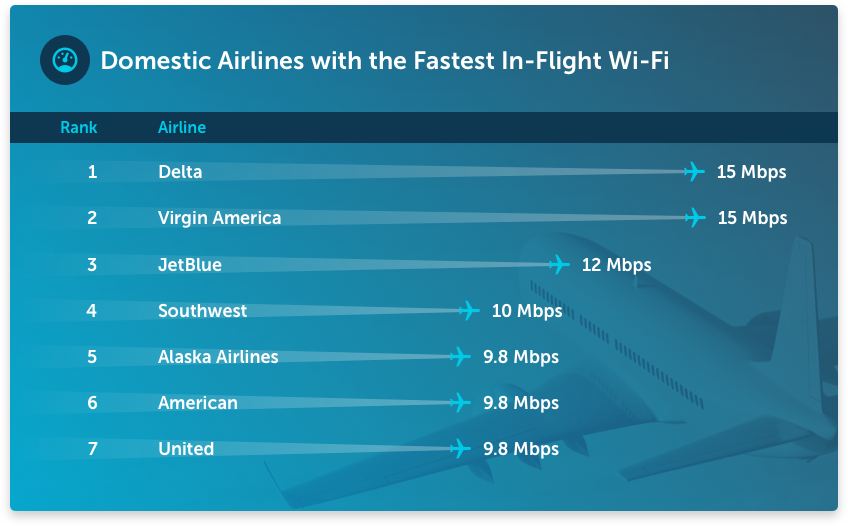
If you’re simply looking for the fastest in-flight Wi-Fi, go for Delta or Virgin America. However, while both these airlines offer in-flight Wi-Fi up to 15 Mbps, they vary in price enormously.
- Delta should be your first choice. It charges up to $16 per day for in-flight Wi-Fi, which it offers on 98% of its ASM.
- If you can’t find a Delta flight that offers Wi-Fi and matches your travel time and destination, your next choice should be Virgin America. Getting Wi-Fi on Virgin America will cost you up to $25 per day, but it’s available on every flight.
Frontier Airlines, Hawaiian Airlines, and Spirit Airlines don’t offer in-flight Wi-Fi.
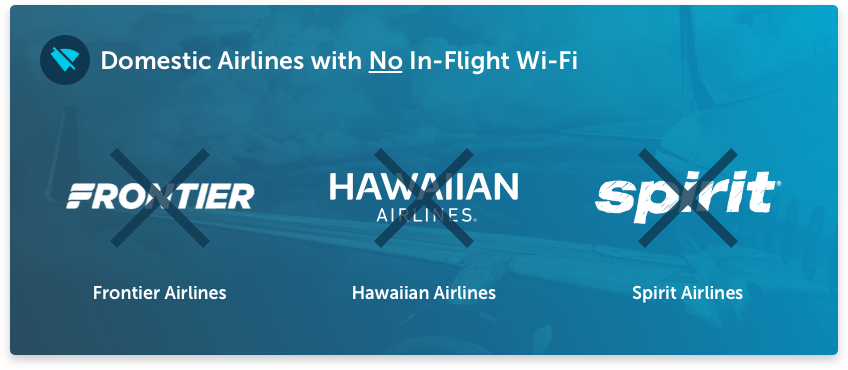
If you need Wi-Fi on your flight, avoid Frontier Airlines, Hawaiian Airlines, and Spirit Airlines. Despite being decently sized domestic airlines, they don’t offer in-flight Wi-Fi services on any of their ASM.
Purchasing Wi-Fi directly from Gogo may be your best option.
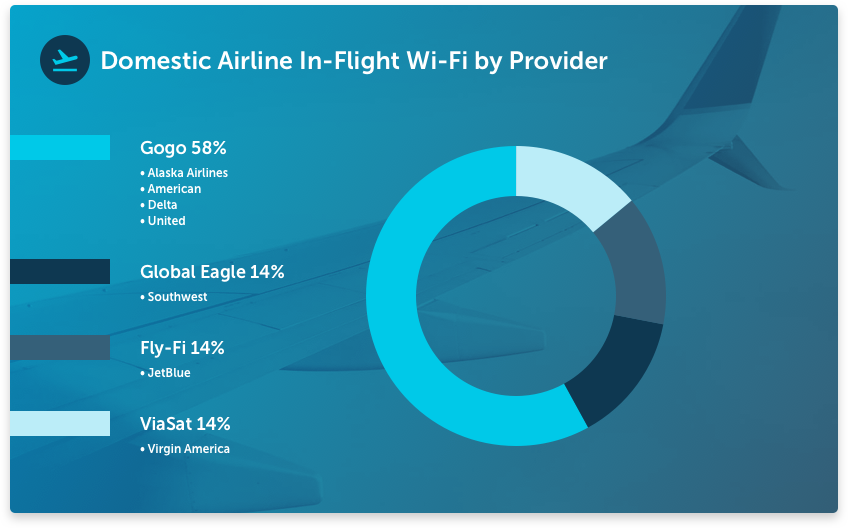
You may have noticed that four out of the seven airlines in the chart all get their internet service from Gogo.
Gogo is an internet provider focused on in-flight service. You can subscribe to in-flight internet service plans directly from Gogo, and you can use that subscription to access the Wi-Fi on Alaska Airlines, Delta, United, or Virgin America. (You can also use it on Air Canada flights, but we’re focusing on US airlines for this piece.)
Gogo offers an array of in-flight internet service plans that vary in duration, coverage area, and even the number of devices you plan to connect. If you travel a lot—especially through cities whose airports service a high volume of flights from Gogo’s participating airlines—Gogo plans may be more cost-effective than purchasing in-flight Wi-Fi service from the airlines themselves. This may also help you avoid the per-flight Wi-Fi fees charged by Virgin America and United.
Top Domestic Airline Wi-Fi Services for Business Travel
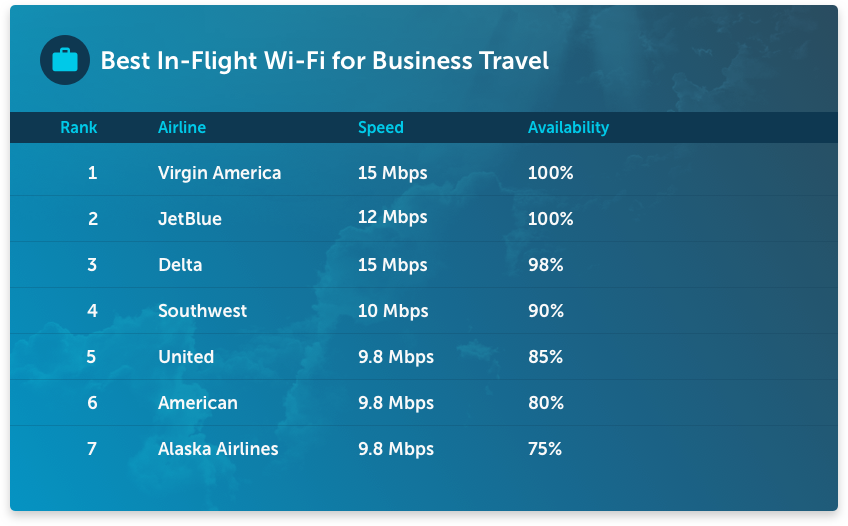
When traveling for business, out-of-pocket cost isn’t as high of a concern. If you’re an employee, your company will likely be footing the bill. And if you’re a business owner, paying for reliable in-flight internet could keep your employees productive while traveling. After all, you gotta spend money to make money!
Virgin America and Jet Blue rank number one for in-flight Wi-Fi when traveling for business.
With the top speed and availability, Virgin Airlines and Jet Blue are the best choices for business travelers who need in-flight Wi-Fi. You’re virtually guaranteed to have Wi-Fi on any domestic flight, and the speeds are as good as you’ll find. With this great option, your productivity will be taking off shortly after your plane does.
If you don’t have Virgin America or Jet Blue as an airline option, Delta is a great second choice. It offers in-flight Wi-Fi that’s just as fast as Virgin America and Jet Blue’s and less expensive than Virgin America’s. The only reason it ranks behind Virgin America is because it’s not quite as available across all of Delta’s ASM.
Methodology
In short, we used the availability statistics published in routehappy.com’s 2017 Wi-Fi Report and then tracked down the Wi-Fi speeds and prices offered by each airline. (This sounds easier than it was.)
Some airlines don’t publish their in-flight Wi-Fi information. So, to get it, our team spent days contacting various departments at some of these airlines—hounding them via email, phone, and social media. We’re not complaining—we’re happy to go the extra mile to help consumers. But the fact that this information was so hard to find does raise some concerns about transparency. We think airlines could go a long way to reduce consumer frustration by making this information more readily available.
Once we had all the information, our data analyst created a formula that weighted each variable based on its likely importance to the consumer. The formula also factored in any additional costs. For example, Virgin America and United were both hurt in the ranking because if you transfer flights on those airlines, you have to pay an additional fee to use the Wi-Fi on any subsequent flights—even if you board them within the same day.
As mentioned before, we put less weight on cost for our business in-flight Wi-Fi rankings. Instead, we focused on availability and speed because they have more potential to impact your work productivity while travelling.
Make informed internet decisions in the air and on the ground.
In addition to this analysis, our team at HighSpeedInternet.com are experts on Internet Service Providers (ISPs) in the United States. We have a database of over 1,200 internet providers and the zip codes in which they’re available.
So, when your traveling’s done and you’re ready to find a terrestrial Internet Service Provider, go to HighSpeedInternet.com and enter your zip code. We’ll show you the ISPs available in your area and help you choose the one that’s right for you.
Author - John Dilley
With over five years writing about the internet industry, John has developed a deep knowledge of internet providers and technology. Prior to writing professionally, John graduated with a degree in strategic communication from the University of Utah. His education and experience make his writing easy to understand, even when covering complex topics. John’s work has been cited by Xfinity.com, PCMag, The Washington Post, Los Angeles Times, and more.



